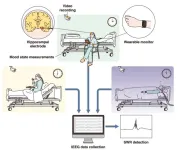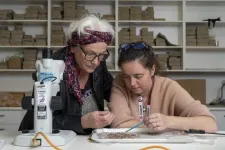Key points:
In a large, multinational investigation of the link between extreme temperatures and stroke mortality, researchers found that of every 1,000 ischemic or hemorrhagic stroke deaths, about 11 were attributable to extreme cold and hot days.
The study also found that low-income countries bore a higher burden of heat-related hemorrhagic stroke mortality than high-income countries.
The researchers foresee an increase in fatal strokes, as well as a widening disparity in stroke mortality between high- and low-income countries, as climate change continues to escalate and temperatures become more extreme.
Boston, MA—Extreme heat and extreme cold are both associated with increased risks of death from ischemic and hemorrhagic stroke, according to a new study led by Harvard T.H. Chan School of Public Health. The researchers found that the link between extreme temperatures and stroke mortality was stronger in low-income countries than in high-income countries.
The study will be published on May 22, 2024, in Stroke.
“Our findings are another step toward understanding the effects of climate change on stroke,” said lead author Barrak Alahmad, research fellow in the Department of Environmental Health. “As temperatures become more extreme, we foresee an increase in fatal strokes and a widening disparity in stroke mortality between high- and low-income countries, as the latter are likely to bear the brunt of climate change.”
Previous research on the relationship between extreme temperatures and stroke mortality has yielded mixed or inconclusive results. Most studies have been limited to single cities or countries, mostly high-income, and few have differentiated between stroke subtypes. To address these gaps, the researchers leveraged the Multi-Country Multi-City Network, a global environmental health consortium, to build a multinational, multiregional database of ischemic and hemorrhagic stroke mortality. The database was composed of more than 3.4 million ischemic stroke deaths and more than 2.4 million hemorrhagic stroke deaths, reported between 1979 and 2019 across 522 cities in 25 countries.
The study found that for every 1,000 ischemic or hemorrhagic stroke deaths, about 11 were attributable to extreme cold or hot days. Of those 11 deaths, the coldest and hottest 2.5% of days contributed to 9.1 and 2.2 excess deaths, respectively. Out of every 1,000 hemorrhagic strokes, the coldest and hottest 2.5% of days contributed to 11.2 and 0.7 excess deaths. The study also found that low-income countries bore a higher burden of heat-related hemorrhagic stroke mortality than high-income countries and may bear a higher burden of cold-related hemorrhagic stroke mortality as well (though evidence was suggestive, not conclusive). It did not find a relationship between countries’ gross domestic product and risk of temperature-related ischemic stroke mortality.
The researchers hypothesized that better indoor temperature control systems and lower rates of outdoor work in high-income countries, as well as worse-quality health care in low-income countries, might explain the disparities. They noted that further study is necessary to uncover the drivers of low-income countries’ higher burden of temperature-related hemorrhagic stroke mortality and identify helpful interventions.
Limitations of the study included that it was limited in its geographic scope—rural settings and countries in South Asia, Africa, and the Middle East were underrepresented—and that individual-level demographics were not collected or examined. Additionally, the study only focused on stroke deaths; additional research into the incidence of non-fatal strokes would provide further understanding of the actual burden of temperature and strokes.
“We call on professional stroke societies to invest in more of this research, especially as climate change continues to escalate, and to shine a brighter light onto emerging environmental risk factors that will make strokes—already a significant driver of mortality worldwide—even deadlier,” Alahmad said.
Other Harvard Chan co-authors included Antonella Zanobetti, Joel Schwartz, and Petros Koutrakis.
The study was supported by the Kuwait Foundation for the Advancement of Science (grant CB21-63BO-01), the Medical Research Council-UK (grant MR/V034162/1), the European Union’s Horizon 2020 Project Exhaustion (grant 820655), the Swiss National Science Foundation (grant TMSGI3_211626), and the National Institutes of Health (grant R01ES034038).
“Extreme Temperatures and Stroke Mortality: Evidence from A Multi-Country Analysis,” Barrak Alahmad, Haitham Khraishah, Meghana Kamineni, Dominic Royé, Stefania I. Papatheodorou, Ana Maria Vicedo-Cabrera, Yuming Guo, Eric Lavigne, Ben Armstrong, Francesco Sera, Aaron S. Bernstein, Antonella Zanobetti, Eric Garshick, Joel Schwartz, Multi-Country Multi-City (MCC) Network. Michelle. Bell, Fahd Al-Mulla, Petros Koutrakis, Antonio Gasparrini, Stroke, May 22, 2024, doi: 10.1161/STROKEAHA.123.045751
Visit the Harvard Chan School website for the latest news, press releases, and multimedia offerings.
###
Harvard T.H. Chan School of Public Health brings together dedicated experts from many disciplines to educate new generations of global health leaders and produce powerful ideas that improve the lives and health of people everywhere. As a community of leading scientists, educators, and students, we work together to take innovative ideas from the laboratory to people’s lives—not only making scientific breakthroughs, but also working to change individual behaviors, public policies, and health care practices. Each year, more than 400 faculty members at Harvard Chan School teach 1,000-plus full-time students from around the world and train thousands more through online and executive education courses. Founded in 1913 as the Harvard-MIT School of Health Officers, the School is recognized as America’s oldest professional training program in public health.
END


